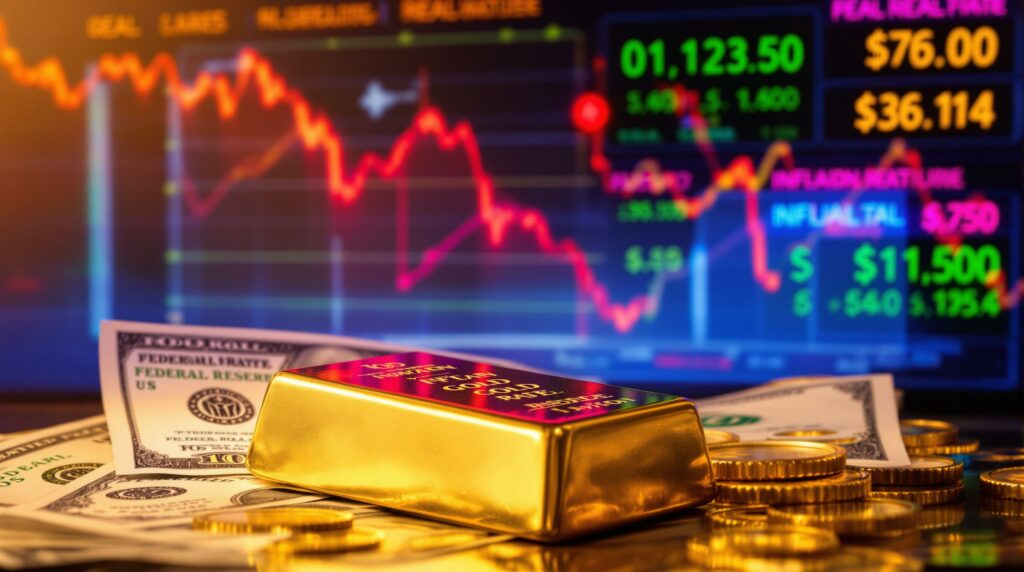What Is the Relationship Between Interest Rates and Gold Prices?
Gold typically exhibits an inverse relationship with interest rates – when rates fall, gold prices often rise, and vice versa. This connection forms one of the fundamental principles that gold investors monitor when making decisions about precious metals allocation in their portfolios.
The relationship exists primarily because gold is a non-yielding asset. Unlike bonds, dividend-paying stocks, or interest-bearing accounts, physical gold generates no income stream for its holder. This creates an opportunity cost dynamic that shifts with interest rate movements.
When central banks like the Federal Reserve raise interest rates, yield-bearing investments become comparatively more attractive. Investors can earn guaranteed returns through government bonds or certificates of deposit, making the prospect of holding a non-yielding asset like gold less appealing.
Conversely, when interest rates decline, the opportunity cost of holding gold diminishes. The reduced yields available from traditional safe-haven investments make gold's lack of yield less of a disadvantage, while its qualities as a store of value and potential inflation hedge become more prominent.
The Fundamental Connection Explained
The inverse relationship between gold and interest rates manifests most clearly when examining real interest rates – nominal rates minus inflation. When real rates turn negative (inflation exceeds interest rates), gold typically performs exceptionally well.
During periods of declining or negative real interest rates, holding cash or bonds can actually erode purchasing power. This economic environment creates ideal conditions for gold appreciation, as investors seek alternative stores of value.
Historical data confirms this pattern. Gold's strongest bull markets have coincided with periods of declining real interest rates, such as the 1970s stagflation era and the post-2008 financial crisis period of ultra-loose monetary policy.
The relationship isn't always immediate or direct, however. Market expectations about future rate movements often drive gold prices before actual rate changes occur. This forward-looking dynamic explains why gold sometimes moves contrary to current interest rate trends – it's pricing in anticipated future policy shifts.
Why Gold Responds to Interest Rate Changes
Several key mechanisms explain gold's sensitivity to interest rate fluctuations:
Opportunity Cost Factor: As interest rates fall, the opportunity cost of holding non-yielding gold decreases relative to interest-bearing assets, making gold more attractive.
Currency Effects: Interest rate decisions typically impact currency valuations. Lower rates often weaken the domestic currency, making dollar-denominated gold less expensive for foreign buyers and driving up demand.
Store of Value Appeal: During periods of low or negative real returns on conventional assets, gold's historical role as a store of value becomes more significant to investors seeking to preserve purchasing power.
Investment Flows: Institutional investors and fund managers adjust portfolio allocations based on interest rate environments, potentially increasing gold positions when rates decline.
Gold's relationship with interest rates also demonstrates why it often serves as an effective portfolio diversifier. When bonds and savings accounts offer diminished returns during low-rate environments, gold frequently provides counterbalancing performance.
How Do Federal Reserve Decisions Impact Gold Markets?
Federal Reserve monetary policy decisions represent some of the most significant catalysts for gold price movements. The Federal Open Market Committee (FOMC), which determines U.S. interest rate policy, wields enormous influence over global gold markets through both direct policy actions and forward guidance.
Gold traders vigilantly monitor Fed communications, economic projections, and policy statements for clues about future interest rate directions. The anticipation of policy changes often drives substantial gold price movements before any actual rate adjustment occurs.
Market reactions to Fed decisions can be complex and sometimes counterintuitive. A rate cut that was already fully anticipated by markets might cause minimal gold price movement, while unexpected language in the accompanying statement could trigger significant volatility.
The FOMC's Influence on Gold Pricing
FOMC meetings serve as critical price catalysts for gold markets, with several noteworthy patterns:
Pre-Meeting Positioning: Gold often experiences increased volatility in the days leading up to scheduled FOMC meetings as traders position for potential outcomes.
Immediate Reactions: The initial market response to Fed announcements can be sharp but sometimes reverses once investors fully digest the policy implications.
Dot Plot Impact: The Fed's "dot plot" showing individual committee members' rate projections frequently influences gold prices by revealing the anticipated pace and magnitude of future rate movements.
Volume Surges: Trading volume in gold futures and ETFs typically spikes dramatically during and immediately after Fed announcements, reflecting their importance to market participants.
The Fed's influence extends beyond U.S. borders. As the world's dominant central bank, Federal Reserve decisions create ripple effects through global interest rates, currency markets, and international gold pricing in various denominations.
Reading Between the Lines: Fed Communications and Gold
The nuanced language in Fed communications often proves more impactful on gold markets than the actual rate decisions themselves. Market participants scrutinize every word change between statements for policy clues.
Hawkish vs. Dovish Tones: When the Fed adopts a hawkish stance (suggesting tighter monetary policy), gold prices typically face downward pressure. Conversely, dovish language (indicating easier policy) generally supports gold prices.
Inflation Commentary: Fed assessments of inflation trends receive particular attention from gold traders. When the Fed expresses increased concern about inflation, gold often benefits from its perception as an inflation hedge.
Forward Guidance: The Fed's indications about future policy direction frequently generate stronger market reactions than current rate decisions. Suggestions of multiple future rate cuts, for example, can trigger significant gold rallies.
Press Conference Nuances: The Fed Chair's press conference following policy announcements provides additional context that can substantially influence gold prices. Unscripted responses to reporter questions sometimes reveal insights not captured in the formal statement.
Gold market participants also closely analyze Fed meeting minutes released three weeks after each FOMC meeting. These documents often contain more detailed discussions of economic conditions and policy considerations that further influence gold trading strategies.
When Do Real Interest Rates Matter More Than Nominal Rates?
When analyzing gold's relationship with interest rates, real interest rates provide significantly more predictive power than nominal rates. The real interest rate – nominal rate minus inflation – represents the actual return on capital after accounting for purchasing power erosion.
Gold's inverse relationship with real interest rates is one of the strongest correlations in financial markets. When real rates decline or turn negative, gold prices typically appreciate substantially. This pattern has remained consistent across diverse economic environments and time periods.
Understanding this relationship helps explain why gold can rally even during periods of rising nominal rates – if inflation is increasing faster than interest rates, real rates decline, creating supportive conditions for gold despite higher nominal yields.
Understanding the Critical Real Rate Factor
The real interest rate dynamic explains several important gold market behaviors:
Negative Real Rate Impact: When real interest rates turn negative, holding cash or bonds guarantees loss of purchasing power. This creates powerful incentives to allocate capital to alternative stores of value like gold.
Rate Direction vs. Level: The direction of real rate movement often matters more than the absolute level. Gold can perform well in environments where real rates remain positive but are trending downward.
Inflation Expectations: Market-based measures of inflation expectations, such as breakeven rates derived from Treasury Inflation-Protected Securities (TIPS), provide valuable signals for potential gold price movements.
Central Bank Credibility: Gold prices often reflect market assessment of central banks' ability to control inflation. When credibility weakens, gold typically strengthens, regardless of nominal rate movements.
This relationship also explains why gold performed strongly during certain historical periods despite high nominal interest rates – such as the 1970s when double-digit inflation exceeded even the elevated interest rates of that era.
The Inflation-Adjusted Interest Rate Impact
The strongest historical gold bull markets have coincided with periods of negative real yields, highlighting gold's role as an inflation hedge:
1970s Bull Market: Gold rose from $35 to over $800 per ounce during a period of deeply negative real interest rates as inflation surged past 14% while nominal rates lagged.
2000s Bull Market: Gold's rise from approximately $250 to over $1,900 accelerated dramatically after the 2008 financial crisis when real rates plunged into negative territory during quantitative easing.
Recent Performance: Gold's strength in 2023-2024 reflects market anticipation of declining real rates as central banks pivot toward easing monetary policy while inflation remains above historical averages.
Investors seeking to understand gold's potential performance increasingly focus on TIPS yields as a proxy indicator for real rates. The 10-year TIPS yield in particular shows strong inverse correlation with gold prices – when this yield declines, gold typically strengthens.
Market perceptions of inflation risks can drive gold prices even when nominal rates remain unchanged. If investors believe central banks will tolerate higher inflation to support economic growth, gold often benefits from this inflation premium regardless of current policy rates.
How Are Current Economic Conditions Affecting Gold Prices?
Current economic indicators present a complex picture for gold investors. Employment data revisions, shifts in Federal Reserve communication, and evolving inflation trends create an environment where gold's traditional relationship with interest rates and gold prices remains highly relevant.
The labor market has shown signs of deterioration, with significant downward revisions to previously reported job growth figures. These revisions suggest economic weakness that could accelerate the timeline for interest rate cuts, potentially supporting gold prices.
Meanwhile, inflation data continues to moderate from previous highs but remains above the Federal Reserve's 2% target. This creates a challenging balancing act for monetary policymakers weighing economic growth concerns against inflation risks.
Labor Market Revisions and Gold Price Implications
Recent employment data revisions highlight economic uncertainty that typically benefits gold markets:
Substantial Downward Adjustments: The Bureau of Labor Statistics has implemented significant downward revisions to employment figures, suggesting the labor market may be weaker than previously believed.
Unemployment Rate Increases: Rising unemployment rates historically correlate with Federal Reserve easing cycles, which tend to support gold prices through both lower opportunity costs and safe-haven characteristics.
Job Quality Concerns: Beyond headline numbers, data suggests a shift toward part-time and lower-quality employment, potentially indicating broader economic fragility that could accelerate monetary easing.
Market Reactions: Gold has responded positively to weakening labor market data as traders price in higher probabilities of Federal Reserve rate cuts in the near term.
The reliability of economic data itself has become a market concern. Major revisions to previously reported figures create uncertainty about the true state of the economy, potentially enhancing gold's appeal as a stable store of value during periods of questionable economic visibility.
Political Influences on Monetary Policy and Gold
Political dynamics can significantly impact monetary policy decisions and gold market sentiment:
Central Bank Independence Questions: Historical precedent shows that political pressure on central banks can influence policy decisions. The incident between President Johnson and Fed Chairman Martin in the 1960s, where Johnson reportedly physically intimidated Martin over interest rate hikes, serves as a reminder that central bank independence faces periodic challenges.
Election Cycle Effects: Presidential election cycles often coincide with attempts to stimulate the economy, potentially influencing Federal Reserve decision-making and creating environments supportive of gold prices.
Fed Composition Changes: The appointment of new Federal Reserve governors can signal shifts in the committee's policy bias. Markets closely monitor the ideological balance between "hawks" and "doves" on the FOMC.
Economic Narrative Shifts: Political focus on specific economic indicators can influence market perceptions about which data points will drive monetary policy, affecting how gold traders interpret economic releases.
These political factors add another layer of complexity to gold's relationship with interest rates. Markets must assess not only economic data but also potential political influences on monetary policy when forecasting gold price movements.
What Historical Patterns Exist Between Rate Cycles and Gold?
Examining historical rate cycles provides valuable context for understanding potential gold price trajectories during monetary policy shifts. Gold has demonstrated consistent patterns during previous Federal Reserve easing cycles that may offer guidance for current market conditions.
Since 1970, gold has shown strong performance during the initial phases of Federal Reserve rate-cutting cycles. This pattern reflects both the direct impact of falling opportunity costs and the economic conditions that typically prompt central banks to cut rates.
Understanding these historical relationships can help investors develop more effective strategies for gold allocation during evolving monetary policy environments.
Gold Performance During Rate Cut Cycles
Historical data reveals several important patterns in gold's behavior during Federal Reserve easing cycles:
Initial Cut Impact: The first rate cut in a cycle typically generates the strongest positive response in gold prices, often triggering rallies of 5-10% within weeks of the announcement.
12-18 Month Performance: Gold has averaged gains of approximately 20-30% during the first 12-18 months of rate-cutting cycles since 1970, though individual cycle performance has varied significantly.
Cycle Magnitude Effects: The depth and pace of rate cuts influence gold's performance trajectory. Aggressive cutting cycles (like 2007-2008) have generally produced stronger gold returns than gradual easing periods.
Terminal Rate Expectations: Market projections about the ultimate endpoint of the cutting cycle significantly impact gold pricing throughout the easing process. Lower anticipated terminal rates typically support stronger gold performance.
Gold's relationship with rate cuts isn't uniform across all cycles, however. The economic context surrounding the cuts matters tremendously. Rate cuts during crisis periods (like 2008) tend to generate stronger gold responses than those implemented during mild economic slowdowns.
Comparing Current Conditions to Previous Gold Bull Markets
Current economic conditions share notable similarities with previous periods that preceded major gold rallies:
Real Rate Trajectory: The anticipated decline in real interest rates mirrors conditions that sparked previous gold bull markets, particularly the early 2000s period.
Economic Uncertainty: Rising concerns about economic growth sustainability create an environment similar to previous transitional periods that benefited gold.
Inflation Context: While inflation has moderated from recent peaks, it remains above historical averages, creating a backdrop reminiscent of periods favorable for gold.
Central Bank Positioning: The transition from tightening to easing monetary policy represents a critical inflection point that has historically signaled major shifts in gold market momentum.
Historical comparisons suggest potential for significant gold appreciation if the Federal Reserve embarks on a sustained easing cycle. Previous transitions from hiking to cutting regimes have often marked the beginning of multi-year advances in gold prices.
How Should Investors Approach Gold in the Current Rate Environment?
Developing an effective gold investment strategy requires balancing tactical opportunities created by interest rate movements with strategic portfolio considerations. The current environment of anticipated rate cuts presents both potential rewards and risks for gold investors.
Successful gold investment during rate transition periods demands clear planning, appropriate vehicle selection, and realistic expectations about price behavior. Different approaches may be suitable depending on investment horizons, risk tolerance, and portfolio objectives.
Investors should consider not only when to allocate to gold but also how to structure that exposure to maximize potential benefits from the evolving interest rate landscape.
Strategic Considerations for Gold Allocation
Several strategic approaches can help investors navigate gold markets during interest rate transitions:
Diversification Framework: Consider gold's correlation benefits rather than focusing exclusively on return potential. Research suggests optimal gold allocations of 5-10% in diversified portfolios, with potential for tactical increases during favorable rate environments.
Vehicle Selection: Different gold investment vehicles respond differently to interest rate changes:
- Physical gold offers direct price exposure but involves storage considerations
- Gold ETFs provide convenient exposure but carry expense ratios
- Gold mining stocks offer operational leverage to gold prices but introduce company-specific risks
- Gold royalty companies provide exposure with different risk-reward characteristics
Time Horizon Alignment: Match gold investment approaches with appropriate time horizons. Short-term traders might focus on FOMC meeting catalysts, while long-term investors should consider secular trends in real interest rates.
Risk Management: Implement position sizing and risk parameters appropriate for gold's historical volatility. While gold can serve as a portfolio stabilizer during certain periods, it experiences significant price fluctuations that require thoughtful risk management.
Investors should also recognize gold's changing role across different economic environments. During periods of falling real rates, gold often performs best as a strategic investment rather than merely a tactical trade.
Timing Considerations for Gold Purchases
While perfect timing remains challenging, several approaches can improve entry and exit decisions for gold investments:
Rate Cut Probability Indicators: Tools like the CME FedWatch Tool provide market-implied probabilities for future rate decisions. Historical data suggests gold often begins rallying when markets price in high probabilities (>70%) of rate cuts within the next two meetings.
Dollar-Cost Averaging: Implementing a systematic purchase program during rate transition periods can mitigate timing risk while building positions during favorable interest rate trends.
Technical Confirmation: Combining interest rate analysis with technical price indicators can help identify higher-probability entry points. Breakouts above significant resistance levels often coincide with shifting rate expectations.
Economic Release Calendar: Plan position adjustments around key economic releases that influence rate expectations, particularly inflation reports and employment data.
Investors should remain conscious that markets price in expected rate movements well before they occur. This forward-looking dynamic means gold often rallies in anticipation of rate cuts, potentially peaking when the actual cuts begin if they've been fully priced in advance.
What Other Factors Influence Gold Beyond Interest Rates?
While interest rates represent a critical driver for gold prices, numerous additional factors influence the precious metal's valuation. Understanding these complementary drivers helps investors develop more nuanced perspectives on gold's potential performance across different market environments.
These additional factors sometimes reinforce interest rate effects but can also counteract them, explaining periods when gold moves contrary to what interest rate relationships alone would suggest. A comprehensive gold investment approach considers this full spectrum of influences.
Complementary Drivers of Gold Prices
Several important factors beyond interest rates significantly impact gold markets:
Geopolitical Tensions: International conflicts, trade disputes, and political instability often trigger safe-haven flows into gold regardless of prevailing interest rates. During acute geopolitical crises, these security motivations can temporarily override interest rate considerations.
Central Bank Purchasing: Official sector gold buying has reached record high analysis levels in recent years, with central banks diversifying reserves away from dollars. This structural demand provides underlying support for gold prices independent of interest rate environments.
**
Are You Ready to Discover the Next Big Mineral Find?
Uncover actionable insights on major ASX mineral discoveries with Discovery Alert’s proprietary Discovery IQ model. Start your 30-day free trial to gain an edge in identifying high-potential investment opportunities. Explore historic returns on our discoveries page.




